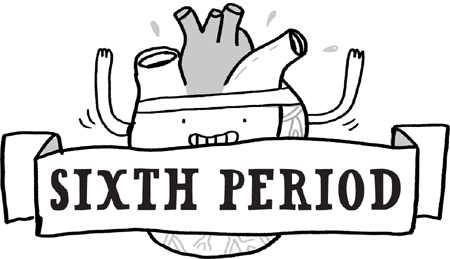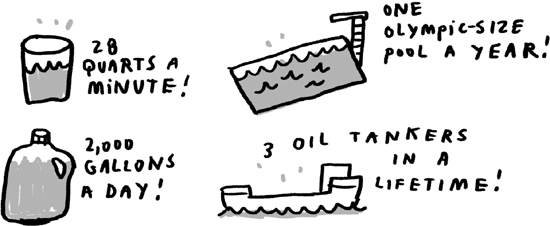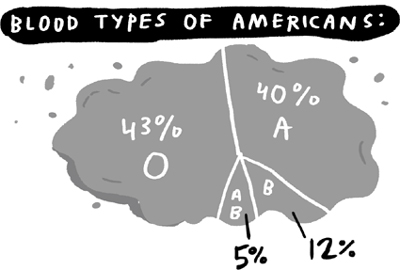
Earlier we talked about the strongest muscles in your body—the jaw, the calf, and so forth. But I left out the muscle that might be the toughest of all, one that has an around-the-clock job and never gets a single day of vacation or even a coffee break. It will flex more than 2.5 billion times over the course of your lifetime. I’m talking about your mouth, chatterbox. No! Just kidding. I’m talking about your heart.
Pretend it’s time for the national anthem or the Pledge of Allegiance or something, Junior Geniuses. Place your hand on your heart. Wrong!

Most people assume that their heart is located on the left side of their body. It’s actually right in the middle of your chest. But it may feel like it’s beating on your left side, because the strongest part of the heart is on the left. Your left lung is actually a little smaller than the right, because of that slight tilt of your heart.

Unless you are the one person in every twelve thousand who has dextrocardia! In that case your heart is a pointed toward the right. It’s not dangerous to have your heart tilt right instead of left, but it can sure confuse doctors for a minute!
Ancient Greek philosophers such as Plato believed that the heart was the seat of emotions, especially anger. I’m glad Plato was a philosopher and not a surgeon. He also believed that the liver was the organ of love and desire. If we believed him, valentine cards would be shaped like livers today.

The heart is not shaped much like a valentine, Junior Geniuses. It’s a hollow muscle about the size of your fist, and it looks like this.

The heart is there to work as a pump. When it squeezes, it pushes blood through your circulatory system of blood vessels. And that’s quite a job, since your body has more than fifty thousand miles of blood vessels—long enough to circle the earth twice!
But the heart is up to the task. Each heartbeat is so powerful that it could squirt blood thirty feet! (If, you know, your heart were sitting on a table. Rather than in your chest. Where it belongs.) That force pushes blood all the way through your body and back three times every minute.
And the heart never gets tired, even though it needs to beat almost one million times every week just to keep you alive! Here’s the amazing volume of blood your heart can pump:

To get that amount of liquid out of a kitchen faucet, you would have to leave it running uninterrupted for forty-five years straight!
(Also, it would be water, not blood. If blood comes out of your kitchen faucet for forty-five years straight, please contact your local utility company.)
EXTRA CREDIT
Your heart has its own electrical system, which means the heart will keep pumping even when removed from the human body! If it’s placed in a liquid solution with the oxygen and ions it needs, a heart will keep beating on its own for more than half an hour.
In 1816 a French doctor named René Laënnec needed to listen to a patient’s heartbeat. But the patient was a pretty young woman, and Dr. Laënnec was too embarrassed to put his ear directly against her chest, which was the common medical practice of the time. Struck by a sudden inspiration, he rolled a piece of paper into a tube and placed one end to his ear and one end to her heart. He had just invented the first stethoscope!

When a doctor listens to your heart during an exam, he or she is hoping to hear this:
Lub-dub. Lub-dub. Lub-dub.
That’s the sound of a healthy heart. Each sound is caused by valves closing between the chambers of your heart. The valves are little flaps of tissue that make sure blood flows in only one direction, like one-way doors at the supermarket.
The lub is the sound of valves closing at the top of your ventricles, so blood won’t flow backward into your atria when the ventricles contract. The ventricles shoot blood out into your arteries. Then the dub is a different set of valves closing: the ones between the ventricles and the arteries. Then the ventricles can relax and refill with new blood from the atria.
Sometimes the doctor hears other sounds in a heartbeat: a “slosh” or a “gallop” or a “murmur.” Maybe a valve isn’t closing all the way, or a ventricle is starting to fail. These sounds can help diagnose a problem before it turns fatal.
HOMEWORK
Tape a funnel into the end of an empty paper towel roll to make a simple home stethoscope. Listen to someone’s heartbeat. Can you hear the lub-dub? Count how many times the heart beats in fifteen seconds and multiply by four. You’ve found your patient’s resting heart rate! What do you think will happen to their heartbeat if you have them exercise for a minute and then you check again? Try it out.
Heart disease is still the leading cause of death for Americans, both men and women, and people of almost all races. But doctors today have some amazing tools in their medical bags when they need to tinker with your ticker.

Lifesaving balloons! When blood vessels get blocked and hardened, doctors do what’s called a balloon angioplasty: They maneuver a tiny balloon through a patient’s arteries to the right spot and blow it up. This widens the artery and improves blood flow. Then doctors can deflate the balloon and remove it.
Pork parts! When a heart valve malfunctions, today’s doctors can replace it with one from an animal heart! Pig heart valves are very similar to ours, so “the other white meat” is the most popular choice.
Shock therapy! Electrical impulses make your heart beat regularly. If that stops working, doctors implant a tiny device called a pacemaker that shocks the heart every second or so, forcing it to lub-dub normally. Today’s models are much better than the first pacemakers from the 1950s. Back then you had to plug yourself into a wall outlet if you wanted to regulate your heart rate!
Heart hoses! In 1929 a German doctor named Werner Forssmann believed he could save lives by inserting a small tube called a catheter into the human heart. But everyone else he talked to thought this would be fatal. Finally he proved he was right . . . by performing the operation on himself! He even tied a nurse to the operating table so that she would have to assist him. The risky operation was a success, and Forssmann later won the Nobel Prize.
Cyborg hearts! The first artificial heart design was patented in 1963 by the inventor Paul Winchell. (Winchell was also an actor and comedian—you probably know him best as the original voice of Winnie-the-Pooh’s friend Tigger!) Today patients with heart failure can be implanted with mechanical devices called VADs, or ventricular assist devices. Former vice president Dick Cheney has one, for example. Some VADs push blood through continuously, not with a series of lub-dubs. That’s right, my friends: Dick Cheney has no pulse!
Of course, the best way to fix an unhealthy heart isn’t a high-tech gadget. It’s a healthy lifestyle! As a grown-up you’ll be able to reduce your risk of heart disease by a whopping 85 percent just by eating well, exercising regularly, and not smoking.
EXTRA CREDIT
The most popular day of the year to have a heart attack? According to emergency room doctors, it’s December 25, followed by December 26. This is due to a combination of cold temperatures, holiday stress, and all the big-time eating and drinking that goes on at this time of year.
Maybe the best way to see how blood flows through your heart and lungs is with a picture. Have you ever seen a map of a train or subway system? Your circulatory system is a kind of mass transit system, but instead of commuters, it delivers things such as oxygen, nutrients, and hormones.

The heart is the Grand Central Terminal of this train line. Blood comes from being oxygenated in the lungs and flows through the pulmonary veins into the left atrium of the heart. Then the blood gets squeezed from the left atrium into the left ventricle, and then leaves the heart via the aorta, your body’s biggest artery. After circulating little oxygen passengers through your whole body, the blood train returns to the heart via the venae cavae, your body’s biggest veins. (Arteries carry blood away from the heart, and veins bring it back.) At this point the train is mostly empty—it’s out of oxygen. The blood flows through the venae cavae into the right atrium, and then into the right ventricle. From the right ventricle the pulmonary artery carries blood to the lungs for a new load of oxygen, and the cycle begins again.
From the arteries and to the veins, blood travels through all the tissues of your body via teeny, tiny little vessels called capillaries. The smallest capillaries are four times as narrow as a human hair. Veins and arteries, on the other hand, can get very big. The femoral arteries that carry blood to your legs are as big as your finger. The aorta can grow as thick as a garden hose!
AIR AND ERROR
The ancient Greek physician Hippocrates is called the “father of Western medicine.” In fact, to this day new doctors still take an oath named for him. But Hippocrates didn’t know everything about medicine. For example, he decided that arteries carried air around the body! Everyone believed this for the next four hundred years, until the Greek doctor Galen realized that the circulatory system was actually for blood, not air.
The ancients also believed—wrongly—that the fourth finger was the only part of the hand connected directly by a vein to the heart. Today that’s why people traditionally wear wedding rings on that finger!

Sometimes we get the idea that oxygenated blood is red and deoxygenated blood is blue. It’s true that your veins look blue under your skin, but that’s just an illusion. Blood in your veins is still red, though it’s a duller shade of red once its oxygen is gone. Call it maroon, maybe. But when those maroon veins are seen through skin, they look bluish.
You know that numb “pins and needles” feeling you get when part of your body “falls asleep”? That’s related to the arteries as well. When too much pressure is put on a limb, the blood vessels get squished and blood supply is cut off from the nerves. Then the nerves get compressed as well, cutting off communication between your limb and your brain. The tingling as your foot “wakes up” is caused by scrambled nerves getting a boost of oxygen from a sudden flow of blood.

Like your heart, your lungs can never rest, because your cells can’t function without oxygen. Not for long, anyway—although in 2012 a German diver set a new world record for holding his breath underwater. He went twenty-two minutes and twenty-two seconds between breaths!

When you inhale, air travels down your windpipe into two tubes called the bronchi.
The bronchi split in two.
Then each branch splits in two again.
This happens many, many more times!
By this time the air tubes are very small indeed. Each of these half billion tiny passageways ends in a little balloon, which is called an alveolus. The alveoli transfer oxygen from the air of each breath into your lungs’ fifteen hundred miles of capillaries.
POP QUIZ!
On the way in or out of your throat, the air vibrates some cords in your larynx, which is what allows you to talk, sing, yell, beatbox, etc. What are those cords called?

Every day you breathe more than thirty-five pounds of air. (If you add those pounds up over the course of your lifetime, that air would weigh as much as a 747 airplane!) And each breath contains a lot of air molecules—20,000,000,000,000,000,000,000 molecules, to be precise. When you breathe out, those air molecules (oxygen, nitrogen, carbon dioxide, and so on) get mixed back into the atmosphere, until someone breathes them in again.

You know what that means, Junior Geniuses? Take a breath and hold it. There is air in your lungs right now that was breathed by a dinosaur. In fact, there’s a 98.2 percent chance that you have an air molecule in your lungs right now that Julius Caesar exhaled in his very last breath when he died in 44 BC! The same goes for the last breath of Michelangelo or Abraham Lincoln or anyone else in history. Do you detect a whiff of peanut butter and banana sandwiches? That must be a molecule from Elvis’s last breath.
Whoa. Okay, you can breathe out now.
If you are not interested in blood, Junior Geniuses, you are really missing out. Of course, if you are a little too interested in blood, you might be a vampire. Hopefully we can find a good level of interest right in the middle.

Blood makes up 8 percent of your body weight—about five quarts in a grown-up. That’s enough to supply 1.2 million mosquito bites! But you don’t want all your blood going to bugs. You need it for dozens of things—not just to circulate oxygen but also to get vitamins and sugars around your body, to collect waste products, to warm some parts of your body and cool others, to fight infection. . . . Blood does it all!

When you are old enough (usually sixteen or seventeen), I highly recommend that you donate blood—not to mosquitoes but to the Red Cross. Every two seconds someone in the United States needs a transfusion, and there’s no artificial substitute for real human blood. So you could literally be saving a life every time you donate! Over the course of a lifetime, you could donate 46.5 gallons of sweet, sweet life-giving blood.
When blood is drawn out of your arm into a test tube, it looks like this.

But then the Red Cross will spin the blood in a centrifuge. (“Centrifuge” is Latin for “spinny machine thing.”) Surprise! Now it looks like this:

The spinning has pushed the dense parts of your blood to the bottom, and left the lightest parts on top. We can clearly see three layers. Turn the page to see them, from top to bottom.

Plasma. The liquid part of your blood—not just water, but also proteins, sugar, hormones, and a bunch of other stuff. Want to see what plasma looks like without giving blood? Pop a blister. The liquid inside a blister is more or less plasma.
White blood cells. The body’s soldiers—they patrol the blood, looking for infections, and when they find one, they gang up on it.
Platelets. Their job is to “clot” your blood when it leaks. That’s why a scab forms when you get hurt. Without that scab, you’d just keep bleeding until you were out of blood.
Red blood cells. They deliver oxygen to your cells, using a protein called hemoglobin that’s good at binding to oxygen. The secret ingredient in hemoglobin is actually iron. You have enough iron in your blood to make one three-inch nail!
I FEEL THE NEED! THE NEED . . . TO BLEED!
When your body is sick, that’s when you really need your red and white blood cells the most. But until about 150 years ago, doctors didn’t know that. They treated lots of illnesses with something called bloodletting—intentionally draining blood from their patients! Sometimes they even used leeches, gross bloodsucking water worms! Millions of patients were harmed or killed by bloodletting over the years—including George Washington.
Doctors performing blood transfusions have to be careful, because not all blood is the same. There are different proteins called antigens in different people’s blood, and if you get an injection of the wrong antigens, it can be fatal. There are four common blood types: A, B, AB, and O.

EXTRA CREDIT
There’s also an extremely rare blood antigen type called Bombay blood. In most of the world it’s found in only one person in every million. In Mumbai, India (the city formerly called Bombay), it’s much more common.
AB blood is called the universal recipient, because people with AB blood can accept transfusions from any other blood type safely. O, on the other hand, is the universal donor. Everyone can accept O-type blood safely.
In Japan it’s believed that blood type is an accurate way to measure personality and compatibility, sort of the way we use astrology. Instead of “What’s your sign? I bet you’re a Gemini!” a Japanese person might say, “What’s your type? I bet you’re AB!”
But even if you have no plans to hit the Tokyo singles scene anytime soon, it’s important to learn your blood type, my friends. That way doctors will know how to treat you in an emergency!